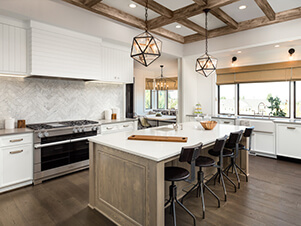Design A Functional Yet Attractive Kitchen Island
Everyone wants a big kitchen. However, such a kitchen can feature too much empty space. Rather than waste that space, many homeowners opt for a kitchen island. Kitchen islands can serve many functions, but they need to be designed well for good utility. Likewise, you’ll want an island that’s an attractive addition to the rest of the kitchen.
Decide on a Function
The ultimate goal of a kitchen island is to facilitate your kitchen tasks. There are several ways the island can accomplish this. Therefore, the first step should be deciding on the primary function.
Many homeowners want their island to facilitate cooking. One option is to design a food preparation island. This should include a sink as well as ample work space — a built-in cutting board is an excellent addition. You should also plan on using small appliances by ensuring there’s enough storage space and outlets.
You could design an island where you do your actual cooking. This island houses the stove and range top. Typically, homeowners also include an overhead vent hood.
Another popular use for kitchen islands is for dining, usually in conjunction with a food preparation or cooking island. It’s possible for such an island to be single-level, but many homeowners prefer a bi-level surface to keep the two spaces separate. The dining level is typically higher and includes an overhang for sliding chairs under.
No matter the function of your island, you’ll need to keep dimensions in mind. This Old House recommends an island size of at least two feet by four feet and with at least 36 inches of clearance all around it.
Settle on a Style
You’ll want your island to be cohesive with the rest of your kitchen. Naturally, one choice is to match the colors and materials exactly. However, this isn’t the only option. You could design an island that complements or even contrasts with the rest of your kitchen décor. This is ideal if you already have a lot of cabinetry in your kitchen.
When planning a contrasting island, imagine how you want it to complement the rest of the décor. Perhaps you want it to add some weight to a light kitchen. Or maybe you want it to add drama with different color and shapes.
To keep a contrasting island cohesive, you’ll need to repeat some elements from the rest of the kitchen. So, if you’re using a different color for the cabinetry, use the same handles as the other cabinets. Or, choose the same countertop material, such as granite, but in a complementary color scheme.
Choose a Countertop Material
In that vein, a large part of the kitchen island goes to increasing workspace — in other words, the countertop. Therefore, your choice of countertop material for the island is just as important as for the rest of the kitchen. It can be the same, but it doesn’t have to be.
If you decide to use a completely different material, there should be a reason for it. For example, you could choose stainless steel or butcher block because you want your island to be a chef’s station.
Don’t Forget about Storage
Your kitchen island should also increase your storage space. Since you’re designing it fresh, consider what your current storage needs are. The cabinets and drawers in your island can provide an excellent resource for clearing up countertops or keeping needful items close to hand.
Along those lines, your use of the island will help drive the storage requirements. For example, if you’re planning on a food preparation island, you’ll want all your cooking utensils stored nearby. You can choose customized inserts that make storing such utensils easier.
Choose the main use and storage needs for your island then ensure it complements the rest of the kitchen in style. Our team of experts at Callier Thompson Kitchen & Bath can help you design a beautiful and functional kitchen island.

